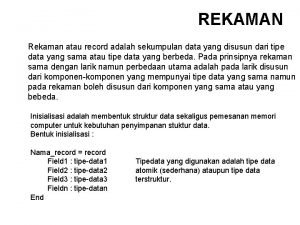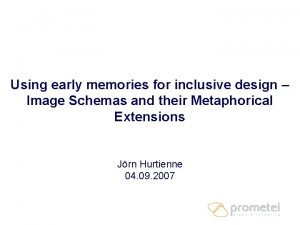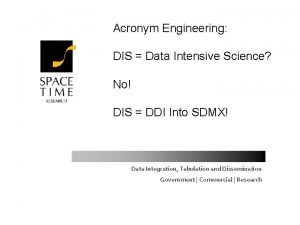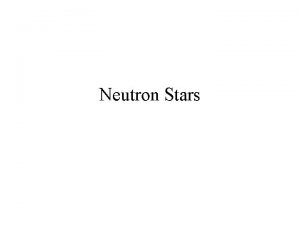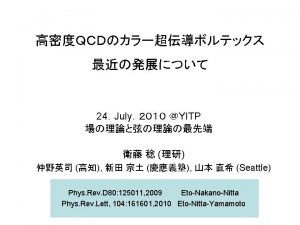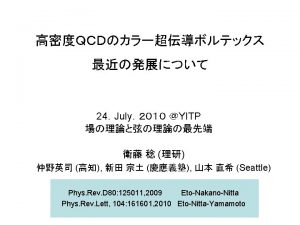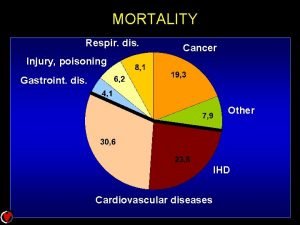Neutron structure functions from inclusive DIS data Neutron














![“Smearing ratios” for the calculations Melnitchouk&Thomas WBA [CTEQ 6 X] Kulagin&Petti Arrington, et al “Smearing ratios” for the calculations Melnitchouk&Thomas WBA [CTEQ 6 X] Kulagin&Petti Arrington, et al](https://slidetodoc.com/presentation_image/b773e715a07272375258898bed396d63/image-15.jpg)

- Slides: 16

Neutron structure functions from inclusive DIS data Neutron structure function Consistent comparison of data, calculations Systematics of the extraction procedure JA, F. Coester, R. J. Holt, T. S. -H. Lee, J. Phys. G 36, 025005 (2009) Evaluation of model dependence JA, W. Melnitchouk, J. Rubin – work in progress John Arrington, Argonne National Lab Workshop on Nucleon Structure at Large Bjorken-x, Oct 13 -15, 2010

Neutron Structure Function n Attempts to extract F 2 n(x) from deuteron and proton data yield large range of results, depending on the model of the deuteron n “Scaled EMC effect” approaches not realistic for high-x, neglect difference in F 2 p and F 2 n, but there is still a wide range if these are excluded n Extraction of F 2 n appears to be very sensitive to the deuteron model, limited by our understanding of nuclear structure for A=2 E 139 E 140

Recent F 2 n Extraction n Similar to previous extractions – emphasis on improved treatment of the data, evaluation of systematics – Fit to F 2 p (from M. E. Christy) – Interpolate Rdp=F 2 d/F 2 p data to Q 02=12 Ge. V 2 • Fit Q 2 dependence at fixed x using full Q 2 range (3 -230 Ge. V 2) • Limited data included to 6<Q 2<30 Ge. V 2, require W 2>3. 5 Ge. V 2 • Average Q 2 for each bin always within factor of two of Q 02 • Interpolation to fixed Q 2 typically 0. 5% n Deuteron evaluated in a light cone impulse approximation (neglect binding), with no “DIS” assumptions (e. g. doesn’t assume scaling, doesn’t neglect k┴), with a two-body effective N-N potential (CD-Bonn) n Parameterize Rnp = F 2 n/F 2 p, calculate Rdp and compare to data, get best fit using MINUIT – Functional form chosen with significant flexibility at large x

Neutron extraction n Global fit to F 2 n/F 2 p, yields good F 2 d/F 2 p [solid curves] n Take Sp, Sn as ratio of bound to free proton/neutron structure functions à F 2 d = F 2 p. Sp + F 2 n. Sn F 2 n = [ F 2 d – F 2 p. Sp ] / Sn or Rnp = [ Rdp – Sp ] / Sn convert D/p points & uncertainties to n/p Plot shows F 2 d per nucleon

Uncertainties related to the extraction n Overall normalization uncertainty in D/p ratio – Straightforward to propagate: Dominant effect at all x values n High-x behavior of the structure function – Modify large x behavior to the point where they start to be inconsistent with SLAC measurements n Uncertainty in Sn(x) – Increased falloff in F 2 n at large x yields increased Sn – Need to reevaluate Sn when varying F 2 n prior to making comparison to F 2 d/F 2 p data

Neutron Structure Function n Ratio of n/p falls with x, no sign of plateau n Agrees with Whitlow (on-shell) result n Lower than Thomas/Melnitchouk, EMC extrapolation n Results depend on nuclear model, deuteron disribution, etc… – Part II of talk n Whitlow extraction of D/p ratios has a large x-Q 2 correlation; usually compared to deuteron calculations at fixed Q 2 – We interpolate data to fixed Q 2 – CTEQ 6 X calculates F 2 at exact kinematics of each point

Q 2 -dependence Take Sp, Sn as ratio of bound to free proton/neutron structure functions à F 2 d = F 2 p. Sp + F 2 n. Sn F 2 n = [ F 2 d-F 2 p. Sp ] / Sn or Rnp = [Rdp – Sp ] / Sn The smearing functions have a large Q 2 dependence at large x values Solid line – Q 2 = 12 Ge. V 2 Red points – Q 2 matches Q 2 of D/p ratio At largest x, Sp changes by ~0. 12 between 12 and 24 Ge. V 2 à Expect Rnp to go down by about 0. 12 if account for this in Thomas and Melnitchouk extraction à Much smaller effect for Whitlow analysis, which took Q 2=20 Ge. V 2

First conclusions: F 2 n extraction n Suggests that a large part of the difference is related to the treatment of the Q 2 dependence of the data – Extractions based on calculated deuteron structure are in reasonably good agreement – Need direct comparison using identical data, extraction procedure, deuteron wavefunction – Sensitivity to nuclear model is less than it appeared • Newer CTEQ 6. 1, CTEQ 6 x analyses (model similar to Melnitchouk and Thomas) yield consistent results (A. Accardi, et al. , ar. Xiv: 0911. 2254)

Large uncertainties or small uncertainties? n CTEQ 6 X: Huge variation in d/u at large x between different extractions A. Accardi, et al. , ar. Xiv: 0911. 2254 n CTEQ 6 X: Global behavior is extremely well constrained even at large x A. Accardi, et al. , ar. Xiv: 0911. 2254

Detailed investigations of model-dependence N 3 L 0 Av 18 CDBonn WJC 2 WJC 1 n Use same data, same extraction procedure, but vary N-N potential (top) and nuclear model (bottom) n Q 02=16 Ge. V 2: Closer to high-x data with large and poorly known Q 2 dependence n Calculate Sp, Sn, using same input F 2 p, F 2 n and same N-N potential (CD-Bonn) REF: Arrington, et al. , CDbonn, MST offshell Melnitchouk&Thomas WBA [CTEQ 6 X] Kulagin&Petti Arrington, et al Rinat, et al Solid: On-shell Dashed: Off-shell [MST or KP]

Detailed investigations of model-dependence N 3 L 0 Av 18 CDBonn WJC 2 WJC 1 n Use same data, same extraction procedure, but vary N-N potential (top) and nuclear model (bottom) n Q 02=16 Ge. V 2: Closer to high-x data with large and poorly known Q 2 dependence REF: Arrington, et al. , CDbonn, MST offshell n Calculate Sp, Sn, using same input F 2 p, F 2 n and same N-N potential (CD-Bonn) Melnitchouk&Thomas WBA [CTEQ 6 X] Kulagin&Petti Arrington, et al Rinat, et al Solid: On-shell Dashed: Off-shell [MST or KP]

Detailed investigations of model-dependence Comparison of different models, potentials using consistent D/p and F 2 p data as input, same procedure

Conclusions n Relatively small dependence on different deuteron calculations, off-shell prescriptions, N-N potentials – F 2 n/F 2 p relatively well known, barring significant extra nuclear effects (e. g. large exotic “EMC effect” in 2 H) – Significant (but not ‘precise’) knowledge of F 2 n at large x – Includes SLAC D/p ratios, but not JLab or non-DIS input n Clean extractions of F 2 n/F 2 p at large x [3 H/3 He, BONUS, PVDIS, neutrino] still very important – Improved (needed) precision in extraction of F 2 n – Sensitive to additional modification of deuteron

Fin…
![Smearing ratios for the calculations MelnitchoukThomas WBA CTEQ 6 X KulaginPetti Arrington et al “Smearing ratios” for the calculations Melnitchouk&Thomas WBA [CTEQ 6 X] Kulagin&Petti Arrington, et al](https://slidetodoc.com/presentation_image/b773e715a07272375258898bed396d63/image-15.jpg)
“Smearing ratios” for the calculations Melnitchouk&Thomas WBA [CTEQ 6 X] Kulagin&Petti Arrington, et al Rinat, et al Solid: On-shell Dashed: Off-shell [MST or KP]

 Cdsl tpin
Cdsl tpin What is static and dynamic data structure
What is static and dynamic data structure Ooa and ood
Ooa and ood Recording data meaning
Recording data meaning Inclusive schema
Inclusive schema Conclusion inclusive education
Conclusion inclusive education Rhtorical devices
Rhtorical devices Examples of hypophora
Examples of hypophora Reimigining disability and inclusive education
Reimigining disability and inclusive education What is inclusive dates
What is inclusive dates Exclusive and inclusive math
Exclusive and inclusive math Examples of mutually exclusive events
Examples of mutually exclusive events Example of mutually inclusive events
Example of mutually inclusive events What is non inclusive practice
What is non inclusive practice Circle inclusive classroom scale
Circle inclusive classroom scale Inclusive curriculum framework
Inclusive curriculum framework Inclusive banking
Inclusive banking



